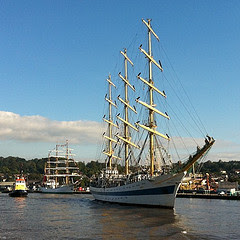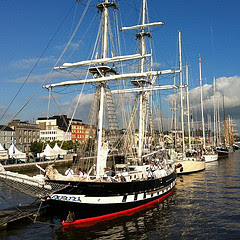Location: 45°28.9'N 27°44.5'W Date: 20.07.11 Time: 18:00 hrs
 The R.V. Celtic Explorer at Galway docks before sailing for the Mid-Atlantic Ridge.
The R.V. Celtic Explorer at Galway docks before sailing for the Mid-Atlantic Ridge. Holland 1 the Marine Institute's remotely operated vehicle will be used to explore the Mid-Atlantic Ridge and enhance our current knowledge of vent and seep systems.
Holland 1 the Marine Institute's remotely operated vehicle will be used to explore the Mid-Atlantic Ridge and enhance our current knowledge of vent and seep systems.Our mission is highly aspirational (and ambitious); we sail on the RV Celtic Explorer to 45°N, a portion of the Mid-Atlantic Ridge, in search of Deep Hydrothermal Vents (otherwise known as Black Smokers). We intend to use the Irish ROV Holland, a deep-water remotely operated vehicle, to survey this idiosyncratic environment and its unique chemosynthetic ecosystems. This mission follows an earlier survey carried out at 45°N by NOC in 2008 which studied an Axial Volcanic Ridge and serendipitously discovered water column signatures typical of high temperature hydrothermal venting. These sparse indications were of dark smoky water, some 2600m below the sparkling blue ocean and hovering above the young volcanic ridge.
Our plan for this expedition is to actually find the source of the venting on the deep sea floor, photographically document it, make high-resolution multibeam sonar images and collect rocks and animals from the site. After this, we plan to steam back toward the Moira mounds, cold-water coral mounds in the Porcupine Seabight, to survey, video and sample these beautiful and ecologically valuable habitats.
On the 15th of July, with everyone onboard, we sailed out of a tranquil Galway Bay towards the setting sun. We passed the Galway Bay esker islands, the Aran Islands and daunting Cliffs of Moher standing proud to port and the Galway's granitic coastline framed by the dominating Dalradian metamorphic mountains of Connemara to starboard. Our sunset departure was captured on film from a helicopter by National Geographic TV who is onboard filming a documentary on our deep sea exploration. There was an air of excited anticipation on board, and some anxiety, as we had been experiencing some technical problems that cost us precious time. We were also aware that we would soon be faced with a howling North-west gale conjuring 3 to 4 metre swells.
With the technical issues solved, the mobilisation, calibration and wet tests of the CTD, underwater navigation system, the ROV, and ROV-mounted multibeam echosounder commenced. Happy with the results we steamed ahead into increasingly worsening weather that would actually average a 7m swell. As the waves grew in height and the ship rolled wildly all night, and with concern for the vessel and its expensive cargo, Denis the Captain decided to keep the vessel faced into the wind and hove-to until conditions eased enough to continue the transit. With most of the scientific team seasick, morale was low and concern increased as precious time ticked by.
Meanwhile, some scientists began to feel better, and began the analysis of previously acquired data. It was crucial at this point to constrain a target location and plan the best course of action. We started by integrating data acquired during the NOC cruise in 2008, using programs such as the 3D visualisation software Fledermaus and 2D geographic information mapping software Arc Map, where various layers of information are draped in one virtual environment. This method of display shows the topography of the ocean floor, the magnetic and sidescan imagery of the ocean floor and varying temperature and chemical signatures of the water column all in one visual space. Using our knowledge and some intuitive guess work we compared each attribute to locate the most plausible position for hydrothermal venting.
The team gathered and discussed the merits of one particular 'hot-spot' of interest; result! As a target location for the first analysis was decided. We then established the best course for our survey: to perform Tow-Yo CTD casts over the area. CTD stands for Conductivity, Temperature and Depth, these are just some of the parameters measured by this hardware. It is to be deployed over the side of the ship and moved through a section of water close to the sea floor (~3000m) by towing it in a yo-yo style we can assess the chemical signatures of the water column at varying heights. This we hoped would indicate the source where the 'buoyant plume' or 'smoke' of minerals ejected from the hydrothermal vent is located.
With the weather improving and a plan of action formed we are confidently steaming toward the target location. By first light we could be on location commencing survey.

And UCC's student website: http://blogs.ucc.ie/wordpress/bees

















